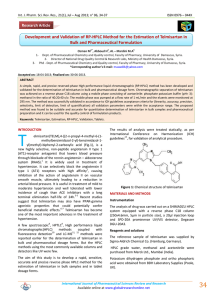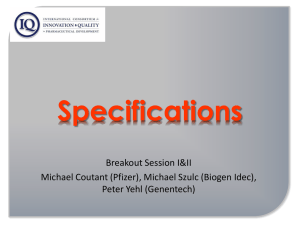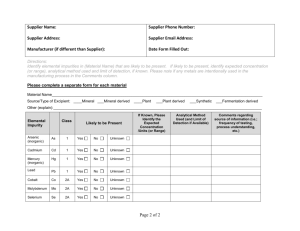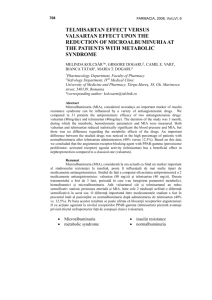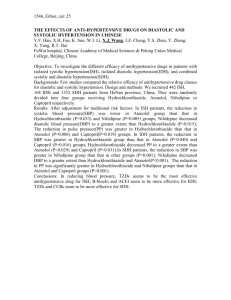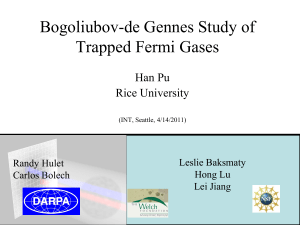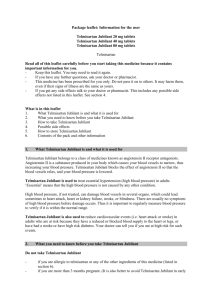Palakurthi Ashok Kumar et all/IJCT 2014 1(1)
advertisement
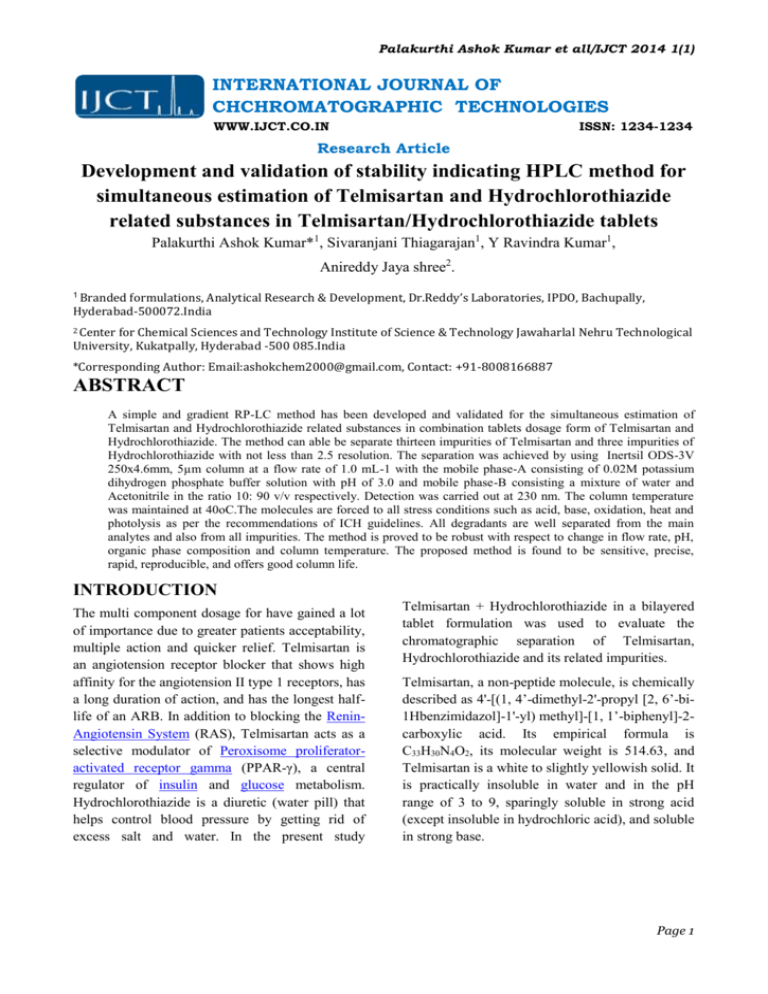
Palakurthi Ashok Kumar et all/IJCT 2014 1(1) INTERNATIONAL JOURNAL OF CHCHROMATOGRAPHIC TECHNOLOGIES WWW.IJCT.CO.IN ISSN: 1234-1234 Research Article Development and validation of stability indicating HPLC method for simultaneous estimation of Telmisartan and Hydrochlorothiazide related substances in Telmisartan/Hydrochlorothiazide tablets Palakurthi Ashok Kumar*1, Sivaranjani Thiagarajan1, Y Ravindra Kumar1, Anireddy Jaya shree2. 1 Branded formulations, Analytical Research & Development, Dr.Reddy’s Laboratories, IPDO, Bachupally, Hyderabad-500072.India 2 Center for Chemical Sciences and Technology Institute of Science & Technology Jawaharlal Nehru Technological University, Kukatpally, Hyderabad -500 085.India *Corresponding Author: Email:ashokchem2000@gmail.com, Contact: +91-8008166887 ABSTRACT A simple and gradient RP-LC method has been developed and validated for the simultaneous estimation of Telmisartan and Hydrochlorothiazide related substances in combination tablets dosage form of Telmisartan and Hydrochlorothiazide. The method can able be separate thirteen impurities of Telmisartan and three impurities of Hydrochlorothiazide with not less than 2.5 resolution. The separation was achieved by using Inertsil ODS-3V 250x4.6mm, 5µm column at a flow rate of 1.0 mL-1 with the mobile phase-A consisting of 0.02M potassium dihydrogen phosphate buffer solution with pH of 3.0 and mobile phase-B consisting a mixture of water and Acetonitrile in the ratio 10: 90 v/v respectively. Detection was carried out at 230 nm. The column temperature was maintained at 40oC.The molecules are forced to all stress conditions such as acid, base, oxidation, heat and photolysis as per the recommendations of ICH guidelines. All degradants are well separated from the main analytes and also from all impurities. The method is proved to be robust with respect to change in flow rate, pH, organic phase composition and column temperature. The proposed method is found to be sensitive, precise, rapid, reproducible, and offers good column life. INTRODUCTION The multi component dosage for have gained a lot of importance due to greater patients acceptability, multiple action and quicker relief. Telmisartan is an angiotension receptor blocker that shows high affinity for the angiotension II type 1 receptors, has a long duration of action, and has the longest halflife of an ARB. In addition to blocking the ReninAngiotensin System (RAS), Telmisartan acts as a selective modulator of Peroxisome proliferatoractivated receptor gamma (PPAR-γ), a central regulator of insulin and glucose metabolism. Hydrochlorothiazide is a diuretic (water pill) that helps control blood pressure by getting rid of excess salt and water. In the present study Telmisartan + Hydrochlorothiazide in a bilayered tablet formulation was used to evaluate the chromatographic separation of Telmisartan, Hydrochlorothiazide and its related impurities. Telmisartan, a non-peptide molecule, is chemically described as 4'-[(1, 4’-dimethyl-2'-propyl [2, 6’-bi1Hbenzimidazol]-1'-yl) methyl]-[1, 1’-biphenyl]-2carboxylic acid. Its empirical formula is C33H30N4O2, its molecular weight is 514.63, and Telmisartan is a white to slightly yellowish solid. It is practically insoluble in water and in the pH range of 3 to 9, sparingly soluble in strong acid (except insoluble in hydrochloric acid), and soluble in strong base. Page 1 Palakurthi Ashok Kumar et all/IJCT 2014 1(1) Telmisartan List of Telmisartan impurities Impurity A 4-methyl-6-(1-methyl-1H-benzimidazol-2-yl)-2-propyl-1H-benzimidazole Impurity B 4′-[[7-methyl-5-(1-methyl-1H-benzimidazol-2-yl)-2-propyl-1Hbenzimidazol-1-yl] methyl]biphenyl-2-carboxylic acid Impurity-C 1,1-dimethylethyl 4′-[[4-methyl-6-(1-methyl-1H-benzimidazol-2-yl)-2-propyl-1H benzimidazol-1-yl]methyl]biphenyl-2-carboxylate Impurity E 1-[(2′-carboxybiphenyl-4-yl) methyl]-4-methyl-2-propyl-1H-enzimidazol6-carboxylic acid Impurity F 4′-[[4-methyl-6-(1-methyl-1H-benzimidazol-2-yl)-2-propyl-1Hbenzimidazol-1-yl] methyl]biphenyl-2-carboxamide Page 2 Palakurthi Ashok Kumar et all/IJCT 2014 1(1) Impurity G 4′-[[4-methyl-6-(1-methyl-1H-benzimidazol-2-yl)-2-propyl-1Hbenzimidazol-1yl]methyl]biphenyl-2-carbonitrile Impurity H 1,1-dimethylethyl 4′-(bromomethyl)biphenyl-2-carboxylate TEL 2 Impurity : Methyl-4’-2[2n-propyl-4-methyl-6-(1-methylbenzimidazole-2-yl)-benzimidazol1-yl-methyl-biphenyl-2-carboxylate CH3 N CH3 N N N N N Cl COOH N N COOH COOH CH3 Diacid impurity Chloro analog impurity Hydrochlorothiazide Hydrochlorothiazide is a white, or practically white, practically odorless, crystalline powder with a molecular weight of 297.74. It is slightly soluble in water, and freely soluble in sodium hydroxide solution. Hydrochlorothiazide is chemically described as 6-chloro-3, 4-dihydro-2H-1, 2, 4benzothiadiazine-7sulfonamide 1,1-dioxide. Its empirical formula is C7H8ClN3O4S2, and its structural formula is Hydrochlorothiazide Page 3 Palakurthi Ashok Kumar et all/IJCT 2014 1(1) List of Hydrochlorothiazide impurities: Impurity A Chlorothiazide. Literature reveals few RP-HPLC methods and is not capable of producing proper resolution between impurity F and impurity E. The main objective is to develop and validate a simple, effective and reproducible HPLC method for the determination of Telmisartan, Hydrochlorothiazide and all related impurities in tablet dosage formulation. The highly polar molecule requires aqueous mobile phase. The mobile phase-A consisting of 0.02M potassium dihydrogen phosphate buffer solution with pH of 3.0 and mobile phase-B consisting a mixture of water and Acetonitrile in the ratio 10: 90 v/v respectively .The quantification was carried out on Inertsil ODS-3V 250x4.6mm 5µm column was selected to enhance retention capacity, sensitivity and specificity of the analytes and their related substances. Gradient flow was used to separate the all impurities with proper separation. The developed method is found to be specific, reproducible and stability indicating. MATERIALS AND METHODS Materials reagents Impurity- B. 4-amino-6-chlorobenzene1,3-disulphonamide (DSA) impurity and impurity D is unspecified impurity. Chloro analogue, diacid impurity and TEL2 are API process impurities. Hydrochlorothiazide (purity-99.5%) and impurities are Chlorothiazide and Disulphonamide. Telmisartan Impurity E and impurity F are obtained from Synpure laboratories. Telmisartan, impurity A, impurity B, Chloro analogue, Diacid impurity and TEL2 are obtained from Dr. Reddy’s laboratories Ltd. Potassium dihydrogen phosphate (AR gradeMerck (India) limited, All other chemicals and solvents used were of analytical grade or HPLC grade. Apparatus The analysis was carried out on waters Alliance HPLC systems 2695 separation module connected to 2996 Photo diode array detector. Data acquisition was carried out using Empower software. Different chromatographic during trials were column used i) Kromosil C18, 125 x 4.0 mm, 5 µm. (make-Waters), ii) Waters Symmetry Shield RP-18, 250x4.6mm, 5µ (make-Waters), iii) Inertsil ODS 3V, 250x4.6mm, 5µ (make-GL Sciences) Telmisartan (purity-99.2%) and impurities A, B, C, D, E, F, G and H are official in European Pharmacopoeia. impurity C is a process related Page 4 Palakurthi Ashok Kumar et all/IJCT 2014 1(1) but 20mM concentration sensitivity of the method. Optimization of Chromatographic conditions: increased the Column Selection Buffer pH Selection Different HPLC columns were used for optimizing the chromatographic condition. To elute highly non polar impurities gradient programme was selected. Different gradient programmes were used to obtain good resolution between the impurities. In Inertsil ODS 3V column all impurities are separated with not less than 2.5 resolutions. The sensitivity of the method also increased with this column in comparison with other columns. The final method conditions Chromatogram shown in Figure1. The pH had an effect on the retention times of the Telmisartan, Hydrochlorothiazide and their related compounds. Resolutions and peak symmetry are found good at pH 3.0. Buffer Selection Different buffers such as ammonium dihydrogen phosphate, potassium dihydrogen phosphate, sodium per chlorate were evaluated for separation of Impurities and system suitability parameters and overall chromatographic performance. In the sequential trials potassium dihydrogen phosphate was found to be suitable for effective separation of parent peak and impurities. It was observed that change in the buffer concentration did not offer significant changes in the elution pattern and resolution, Time (minutes) 0 2 12 30 40 50 51 60 61 65 Mobile phase A 85 85 65 50 40 20 0 0 85 85 Chromatograms of Blank, Placebo, Diluted standard, Telmisartan impurities and Telmisartan & Hydrochlorothiazide Impurities spiked Chromatograms are given Optimized Chromatographic conditions The separation of Telmisartan, Hydrochlorothiazide and all related substances were achieved using 20mM Potassium dihydrogen phosphate buffer, pH adjusted to 3.5 using 1% ortho phosphoric acid solution as mobile phase-A. Water and acetonitirile in the ratio of 10:90 as mobile phase–B at a flow rate of 1.0mL /minute (gradient (table 1)).Detection and purity establishment of the main drug and impurities were achieved using photo diode array (PDA) detector at 230nm.The drug samples and formulation samples were prepared in 0.01M HCl: Methanol (80:20) which is used as a diluent to achieve a concentration of 500µg/mL of Telmisartan and 200 µg/mL and 10µL of the sample were injected. The run time optimized was found to be 65 minutes Gradient programme: Mobile phase B 15 15 35 50 60 80 100 100 15 15 in (figure 1 to figure 5). Relative Retention times (RRTs), Resolutions (R) and Tailing factors (F) of individual peaks are given in (table 2). Page 5 Palakurthi Ashok Kumar et all/IJCT 2014 1(1) Figure 1: Blank Figure 2: Placebo Figure 3: Telmisartan Impurity D Chromatogram Figure 4: Telmisartan Impurities Chromatogram Page 6 Palakurthi Ashok Kumar et all/IJCT 2014 1(1) Figure 5: Telmisartan & Hydrochlorothiazide Impurities spiked Chromatogram Table2: Component Name DSA Chlorothiazide Telmisartan Impurity A Telmisartan Impurity E Telmisartan Impurity F Telmisartan Impurity B Telmisartan Impurity G TEL 2 Dimer acid Telmisartan Impurity C Chloroanalog TEL 1 Telmisartan Impurity H RRT 0.82 0.90 0.37 0.67 0.76 0.85 1.10 1.17 1.40 1.50 1.54 1.62 1.77 Resolution 2.6 10.8 36.4 8.5 7.6 7.2 5.0 16.4 5.5 3.1 6.2 18.1 Tailing 1.2 1.2 1.1 1.1 1.1 1.1 1.1 1.1 1.2 1.0 1.1 1.1 1.0 VALIDATION OF METHOD Specificity The Forced degradation of placebo and formulation was carried out as per ICH guidelines (ICH Q2B). The acid, base, water and oxidation stress conditions were studied out by refluxing both the APIs. The thermal degradation was carried out by heating the APIs at 105◦C.All the stress conditions with purity angle and purity threshold are reported in (table3, 4 & 5). Table 3: Peak purity of Telmisartan in stressed condition. Stress condition As such Sample Acid Degradation (1.7 N HCl, refluxed at 60ºC for 10hours) Base Degradation (1.7 N HCl, refluxed at 60ºC for 10hours) Peroxide degradation (1.7% H2O2 , refluxed at 60ºC for 10hours) Heat degradation (105 ºC for 24hours) Water degradation (10mL H2O , refluxed at 60ºC for 10hours) NA Purity angle 0.847 Purity threshold 1.001 1.5 0.613 1.006 No 2.6 0.508 1.008 No 5.2 0.089 1.018 No 1.4 0.178 1.010 No 0.1 0.131 1.009 No %Degradation Purity flag No Page 7 Palakurthi Ashok Kumar et all/IJCT 2014 1(1) Table 4: Peak purity of Hydrochlorothiazide in stressed condition NA Purity angle 0.376 Purity threshold 0.985 Purity flag No 20.7 0.107 1.054 No 13.2 0.122 1.061 No 23.7 0.159 1.83 No 12.2 0.277 1.170 No 11.6 0.096 1.075 No Stress condition %Degradation As such Sample Acid Degradation (1.7 N HCl, refluxed at 60ºC for 1hour) Base Degradation (1.7 N HCl, refluxed at 60ºC for 1hour) Peroxide degradation (1.7% H2O2 , refluxed at 60ºC for 1hour) Heat degradation (105 ºC for 6hours) Water degradation (10mL H2O , refluxed at 60ºC for 10hours) Table 5: % of Impurities formed in stressed condition Name of the Impurity DAS Chlorothiazide Impurity-A Impurity-E Impurity-F Impurity-B TEL2 Dimer Acid Chloro analogue Impurity-D Acid 20.7 0.1 1.1 - Base 9.9 0.1 2.5 - Robustness The robustness was investigated by varying the conditions of change in the flow rate, pH, column temperature and organic phase composition. The study was conducted at different flow rates of 0.8mL/min, and 1.2mL/min.The mobile phase pH was modified to 2.8 and 3.2 and column temperature was adjusted to 35°C and 45°C to study the effect of pH and column temperature respectively. Organic phase composition was varied to 90% and 110% in mobile phase-B to study the effect of organic phase composition variation. The method % of Impurities Thermal 6.5 0.7 0.1 Peroxide 13.6 0.4 0.9 0.2 0.1 0.1 0.1 Water 42.0 0.1 - was found to be robust with respect to flow rate, pH, column temperature and organic phase composition without any changes in system suitability parameters such as tailing factor and resolution (table 6 & 7). Note: 1) Relative retention times of Telmisartan impurities are calculated with respect to Telmisartan retention time. 2) Relative retention times hydrochlorothiazide impurities calculated with respect hydrochlorothiazide retention time. of are to Table-6: Robustness Parameters Changes in parameters The tailing factor for Hydrochlorothiazide The tailing factor for Telmisartan RRT of DSA RRT of Chlorthalidone Flow rate(mL/min) 0.8 1.2 Between 0.8 Between 0.8 to 1.5 to 1.5 Between 0.8 Between 0.8 to 1.5 to 1.5 0.84 0.81 0.91 0.88 pH 2.8 Between 0.8 to 1.5 Between 0.8 to 1.5 0.82 0.89 3.2 Between 0.8 to 1.5 Between 0.8 to 1.5 0.83 0.90 Page 8 Palakurthi Ashok Kumar et all/IJCT 2014 1(1) RRT of Imp-A RRT of Imp-E RRT of Imp-F RRT of Imp-B RRT of TEL 2 RRT of Dimer acid RRT of Chloro analogue 0.39 0.68 0.78 0.85 1.17 1.39 1.52 0.35 0.67 0.76 0.85 1.18 1.44 1.58 0.37 0.70 0.81 0.90 1.22 1.47 1.62 0.37 0.66 0.73 0.81 1.15 1.34 1.45 Table-7: Robustness Parameters Changes in parameters The tailing factor for Hydrochlorothiazide The tailing factor for Telmisartan RRT of DSA RRT of Chlorthalidone RRT of Imp-A RRT of Imp-E RRT of Imp-F RRT of Imp-B RRT of TEL 2 RRT of Dimer acid RRT of Chloro analogue Column Temperature 35ºC Between 0.8 to 1.5 Between 0.8 to 1.5 0.85 0.91 0.39 0.68 0.79 0.85 45ºC Between 0.8 to 1.5 Between 0.8 to 1.5 0.83 0.90 0.38 0.68 0.77 0.83 1.15 1.37 1.53 1.17 1.37 1.49 Organic phase ratio in mobile phase-B 90% 110% Between 0.8 Between 0.8 to 1.50 to 1.5 Between 0.8 Between 0.8 to 1.5 to 1.5 0.82 0.82 0.90 0.89 0.35 0.38 0.68 0.68 0.77 0.77 0.86 0.84 1.16 1.35 1.46 1.18 1.44 1.61 Robustness Chromatograms: Flow 0.8 mL/minute Page 9 Palakurthi Ashok Kumar et all/IJCT 2014 1(1) Flow 1.2 mL/minute Buffer pH-2.8 Buffer pH-3.2 Column Temperature 35°C Page 10 Palakurthi Ashok Kumar et all/IJCT 2014 1(1) Column Temperature 45°C CONCLUSION The method provides selective quantification of Telmisartan and Hydrochlorothiazide impurities without interference of blank, placebo, thereby affirming stabilityindicating nature of the method. The proposed method is highly selective, ACKNOWLEDGEMENTS The author wish to thank the management of Dr.Reddy’s Laboratories Ltd. for supporting this work. REFERENCES i) ii) iii) ICH Q1B Photo stability testing of new active substances and medicinal products. ICH Q2B Validation of Analytical Procedures: Methodology International Conference on Harmonization of Technical requirements for registration of Pharmaceuticals for Human use, Geneva, Switzerland, 1996. Kiran R. Patil, Vipul P. Rane, Jaiprakash N. Sangshetti and reproducible, specific and rapid. The developed method was robust in the separation and quantification of Telmisartan and Hydrochlorothiazide related impurities. This method can be used in the routine analysis of production samples. Devanand B. Shinde ,journal of Chromatographia,2008,67:455-459 iv) Leena R. Bhat ,Rahul K. Godge ,Asfak T. Vora ,Mrinalini C. Damle ,Journal of liquid chromatography and related technologies,2007,30:3059-3067 v) SB Wankhede, MR Tajne, KR Gupta, SG Wadodkar,Indian journal of pharmaceutical sciences,2007,69:298300 vi) European pharmocopiea, 6.3:2154 vii) NJ Shah, BN Suhagia, RR Shah, PB Shah, ,Indian journal of pharmaceutical sciences,2007,69:202-205 viii) Ben-mei Chen, Yi-zeng Liang , Ya-li Wang, Fu-Liang Deng, Ping Zhou, Fangqiu Guo and Lan-fang Huang, Analytica Chimica Acta,2005,540:367-373 Page 11
